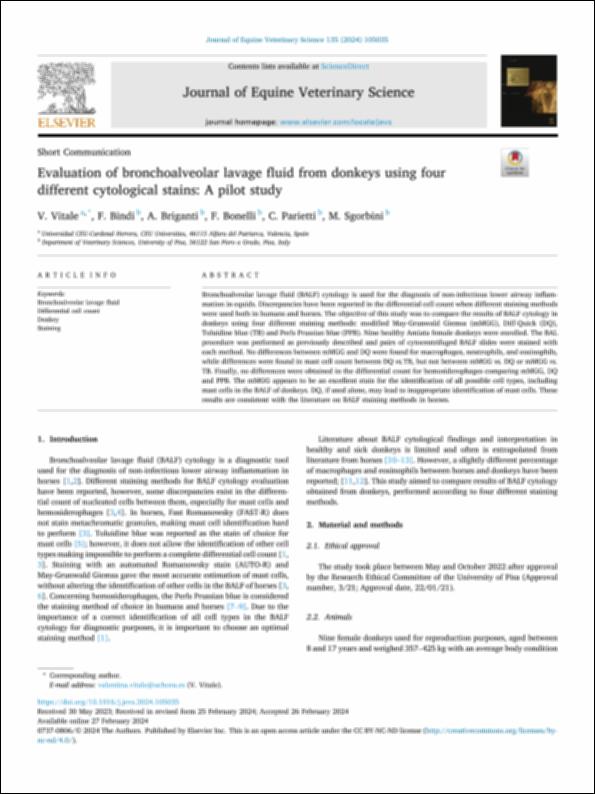Please use this identifier to cite or link to this item:
http://hdl.handle.net/10637/15891Evaluation of bronchoalveolar lavage fluid from donkeys using four different cytological stains: a pilot study
| Title: | Evaluation of bronchoalveolar lavage fluid from donkeys using four different cytological stains: a pilot study |
| Authors : | Vitale, Valentina Bindi, Francesca Briganti, Angela Bonelli, Francesca Parietti, C. Sgorbini, Micaela |
| Keywords: | Primate; Primates; Enfermedad animal; Animal diseases; Caballo; Horses; Biología celular; Cell biology |
| Publisher: | Elsevier |
| Citation: | Vitale, V., Bindi, F., Briganti, A., Bonelli, F., Parietti, C. & Sgorbini, M. (2024). Evaluation of bronchoalveolar lavage fluid from donkeys using four different cytological stains: a pilot study. Journal of Equine Veterinary Science, vol. 135 (apr.), art. 105035. DOI: https://doi.org/10.1016/j.jevs.2024.105035 |
| Abstract: | Bronchoalveolar lavage fluid (BALF) cytology is used for the diagnosis of non-infectious lower airway inflammation in equids. Discrepancies have been reported in the differential cell count when different staining methods were used both in humans and horses. The objective of this study was to compare the results of BALF cytology in donkeys using four different staining methods: modified May-Grunwald Giemsa (mMGG), Diff-Quick (DQ), Toluidine blue (TB) and Perls Prussian blue (PPB). Nine healthy Amiata female donkeys were enrolled. The BAL procedure was performed as previously described and pairs of cytocentrifuged BALF slides were stained with each method. No differences between mMGG and DQ were found for macrophages, neutrophils, and eosinophils, while differences were found in mast cell count between DQ vs.TB, but not between mMGG vs. DQ or mMGG vs. TB. Finally, no differences were obtained in the differential count for hemosiderophages comparing mMGG, DQ and PPB. The mMGG appears to be an excellent stain for the identification of all possible cell types, including mast cells in the BALF of donkeys. DQ, if used alone, may lead to inappropriate identification of mast cells. These results are consistent with the literature on BALF staining methods in horses. |
| URI: | http://hdl.handle.net/10637/15891 |
| Rights : | http://creativecommons.org/licenses/by-nc-nd/4.0/deed.es |
| ISSN: | 0737-0806 1542-7412 (Electrónico) |
| Supported by: | Acuerdo Transformativo – 2024 |
| Issue Date: | Apr-2024 |
| Center : | Universidad Cardenal Herrera-CEU |
| Appears in Collections: | Dpto. Medicina y Cirugía Animal |
Items in DSpace are protected by copyright, with all rights reserved, unless otherwise indicated.


